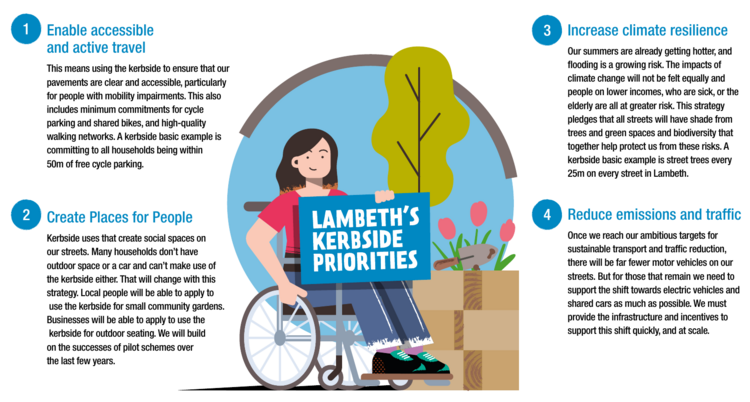Lambeth recently released its Kerbside Strategy. That proposes a reallocation of kerbside space towards active travel, place making, climate resilience, and traffic reduction (94% of Lambeth's kerbside is currently devoted to parking or parking restrictions). [Update: Hounslow adopted a kerbside strategy and parking strategy in July 2024.]
Allocation of kerbside space pretty much solely for car parking is clearly not the most effective use of a limited resource. There will be debates over (for example) what the "right" number of parklets in any given area is, but not even considering the possibility of such a use is clearly not optimal. There is also a significant inequity in granting kerbside space exclusively to car owners, especially when households without cars tend to be deprived in other ways. The details might differ from Lambeth's, but it seems to me that every local authority should have a kerbside management policy that recognises the broad range of potential uses for kerbside space.
But there are two ways in which a strategy such as this would be particularly important for Oxford, and perhaps Oxfordshire.
First of all, this strategy addresses some areas that have been relatively neglected in Oxford: walking and footway quality, place-making, street trees and greenery, and support for people to live without (or with fewer) cars. Active travel schemes so far have focused more on enabling cycling, place-making has focused on large-scale schemes in the city or district centres, urban street trees have been steadily disappearing without being replaced, and traffic restrictions have taken precedence over support for living without cars. (Oxford has done well with main roads, with the Quickways schemes and the inclusion of Action 6 in the Central Oxfordshire Travel Plan, but the LTNs that have gone in have been "bare bones", without any measures complementary to the basic traffic reduction.)
Secondly, this strategy enables action at a local, even "micro" level. While these kerbside measures should be done within a county-wide framework and could be included in, or funded out of, larger schemes, they are fundamentally local and most of them could be implemented incrementally, on a street or even section-of-street basis, with residents taking the lead. (The exceptions mentioned in the Lambeth strategy are cycle hire schemes and flood alleviation.) In contrast, schemes such as the COTP core measures, or even the Quickways cycle lanes and the LTNs, are necessarily conceived of and implemented on a larger scale.
While details might need to be changed, almost everything in the Lambeth Strategy would work for most of Oxford and Oxfordshire's market towns. But different ideas would be needed to expand such a strategy to encompass rural areas.
The Lambeth Kerbside Strategy Priorities
Priority 1 - Enable accessible and active travel
- The kerbside is used to ensure all pavements are clear and accessible, in line with the Lambeth Inclusive Design Principle. Street trees, wheely bins, crossovers and other obstacles are not a barrier to everyday, accessible walking. The kerbside is used to ensure a minimum footway width of 2 metres is provided, in line with Lambeth Local Plan Policy Q6 10.19. The Inclusive Design Principle applies to all pavement and kerbside uses in Lambeth.
- At a minimum, free cycle parking is available every 50 metres on every street in Lambeth.
- At a minimum, secure cycle parking is provided every 100 metres on every street in Lambeth.
- Cycle parking spaces are always cheaper than all residential parking permits
- Borough wide network of bike hire locations, no more than 5 minutes’ walk from every household in Lambeth.
- Places to stop and rest will be available on every street in Lambeth and dropped kerbs at all junctions.
- A new design standard for driveway “crossovers” so they have much less impact on pavements
- Continue to prioritise dedicated Disabled parking bays
- The number and impact of crossovers on footways are minimised to ensure footways are safe from conflicting movements.
- Continued implementation of walking, scooting and wheeling streets where kerbside is needed, through the Lambeth Healthy Routes, School Streets and Low Traffic Neighbourhood programmes
Priority 2 - Create places for people
- All residents have the opportunity to apply for a parklet on their street, where the use of that parklet supports the kerbside priorities. The process is clear and accessible.
- Community parklet grants support the creation of outdoor, green and social spaces in area with both socioeconomic and green space deprivation
- Applications to use public highway for business use has a fair, easy to use process that helps support the resilience and vitality of Lambeth’s businesses.
- Applications are open to teams across the Council to enable the delivery of a wide range of policy outcomes.
Priority 3 - Increase climate resilience
- A tree every 25m on every Lambeth street enabled by the kerbside
- Permeable surfaces including depaving, greening, wildflowers and sustainable drainage make up 10% of Lambeth kerbside
- Kerbside is used to maintain 2m footway around existing mature trees, in line with the Kerbside Inclusive Design Principle and Local Plan Q10.19
- The number of driveway “crossovers” are kept to a minimum in locations where green infrastructure interventions are a priority to manage flood risk
Priority 4 - Support a reduction in traffic and emissions
- Full electric car club vehicles on every street in Lambeth
- A dense borough wide charging network supports the electrification of motor vehicle trips in line with wider Climate Action Plan goals. Charge points are implemented in line with the Inclusive Design Principle (Kerbside Basic 1.1) and Local Plan Q6 10.20. The number and type of chargepoints is set through the Electric Vehicle Strategy.
- Shared cargo bikes available on the kerbside within every neighbourhood across Lambeth, and no more than 5 minutes' walk of all households
- All local high streets have a shared cargo bike hire service
- All local high streets have access to a shared electric van
- Continue to prioritise buses within the kerbside

